Magnification
Differences between and features of prokaryotes and eukaryotes
Diffusion and osmosis
Exceptions to cell theory; multiple nuclei
Cell theory
Liver cell micrograph (Google "liver cell micrograph" so you can get familiar with how they should look)
Route used to export proteins from the cell
Surface area/volume ratio
Identifying organelle structures in eukaryotes and prokaryotes
Facilitated diffusion requirements
Function of ribosomes in cells
Identifying structures of the plasma membrane
Draw and label an animal cell, a bacterium, and a plant cell. Include organelles. Be able to identify organelles by correct name.
Differences between and features of prokaryotes and eukaryotes
Diffusion and osmosis
Exceptions to cell theory; multiple nuclei
Cell theory
Liver cell micrograph (Google "liver cell micrograph" so you can get familiar with how they should look)
Route used to export proteins from the cell
Surface area/volume ratio
Identifying organelle structures in eukaryotes and prokaryotes
Facilitated diffusion requirements
Function of ribosomes in cells
Identifying structures of the plasma membrane
Draw and label an animal cell, a bacterium, and a plant cell. Include organelles. Be able to identify organelles by correct name.


 RSS Feed
RSS Feed